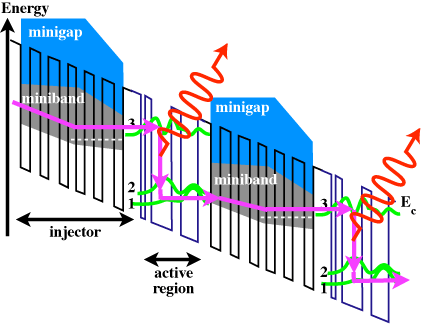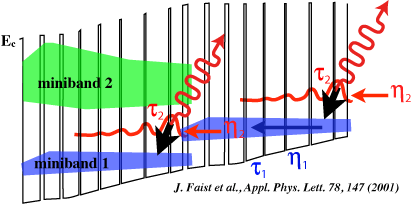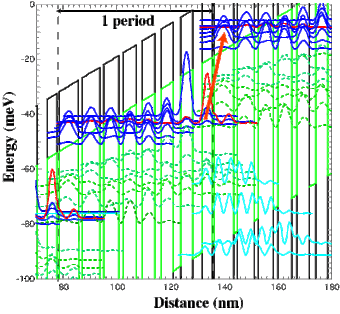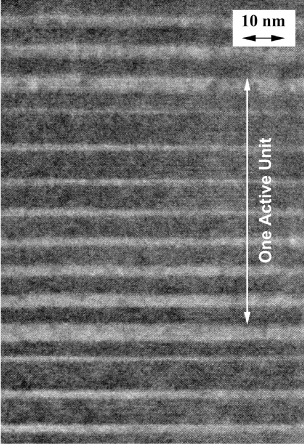Quantum Cascade Lasers

The quantum cascade laser (QCL) is a unipolar laser which was first demonstrated at Bell Laboratories in 1994 by Jerome Faist and colleagues. Electrons cascading down the structure undergo intersubband transitions from which photons are emitted whose frequency is controlled by the width of the quantum wells and m* (see right)
As with every laser there are a number of requirements for lasing to occur:
- population inversion
- stimulated emission
- active region producing gain
- low loss waveguide
- gain > waveguide losses
We have been one of the pioneers of the Si/SiGe quantum cascade lasers with our collaborators at Leeds, Sheffield, Imperial, Heriot-Watt, Queens Belfast and QinetiQ. We have concentrated on far-infrared or terahertz emission and use FTIR to characterise the cascade designs. This includes demonstrating the first strain-symmetrised SiGe quantum cascade emitter, the first terahertz emission from SiGe cascades, the first interwell SiGe cascades operating at terahertz and silicide low loss waveguides. We have also with our collaborators at Heriot-Watt undertaken significant intersubband lifetime measurements using pump-probe measurements with a free electron laser (FELIX) at Utrecht in the Netherlands.

All Si/SiGe quantum cascade designs to date have used holes due to the lower effective mass in the tunnel direction and the segregation of most n-type dopants in CVD growth. The highest gain design in III-V QCLs has been the bound-to-continuum cascade shown on the right. A miniband is used to efficiently inject electrons into a bound state from which the radiative transition is into the next miniband.


Above is shown a design for an eight quantum well Si/SiGe bound-to-continuum cascade and on the left is a TEM image of the grown wafer. The blue states are the square of the envelope functions of the HH states, the cyan wavefunctions are the HH2 states and the dashed green lines are LH states. The radiative transition is from the red HH1 state into the blue miniband as demonstrated by the arrow. Such designs, however, show low gain due to a large number of parasitic transitions to the LH states.
We have been one of the pioneers of the Si/SiGe quantum cascade lasers with our collaborators at Leeds, Sheffield, Imperial, Heriot-Watt, Queens Belfast and QinetiQ. We have concentrated on far-infrared or terahertz emission and use FTIR to characterise the cascade designs. This includes demonstrating the first strain-symmetrised SiGe quantum cascade emitter, the first terahertz emission from SiGe cascades, the first interwell SiGe cascades operating at terahertz and silicide low loss waveguides. We have also with our collaborators at Heriot-Watt undertaken significant intersubband lifetime measurements using pump-probe measurements with a free electron laser (FELIX) at Utrecht in the Netherlands.
Significant Publications:
S.A. Lynch, R. Bates, D.J. Paul, D.J. Norris, A.G. Cullis, Z.Ikonic, R.W. Kelsall, P. Harrison, D.D. Arnone and C.R. Pidgeon, "Intersubband electroluminescence from Si/SiGe cascade emitters at terahertz frequencies" Applied Physics Letters 81, pp1543-1545 (2002)
R. Bates, S.A. Lynch, D.J. Paul, Z. Ikonic, R.W. Kelsall, P. Harrison, D.J. Norris, S.L. Liew, A.G. Cullis, W. Tribe and D.D. Arnone, "Diagonal intersubband transitions in Si/SiGe quantum cascade emitters" Applied Physics Letters 83(20), pp4092-4094 (2003)
S.A. Lynch, D.J. Paul, P. Townsend, G. Matmon, Z. Suet, R.W. Kelsall, Z. Ikonic, P. Harrison, J. Zhang, D.J. Norris, A.G. Cullis, C.R. Pidgeon, P. Murzyn, B.N. Murdin, M. Bain, H.S. Gamble, M. Zhao and W.-X. Ni, "Towards silicon-based lasers for terahertz sources" IEEE Journal of Selected Topics in Quantum Electronics 12, pp1570-1578 (2006)
A. De Rossi, M. Carras and D.J. Paul, "Low-loss surface-mode waveguides for terahertz Si/SiGe quantum cascade lasers" IEEE Journal of Quantum Electronics 42, pp1233-1238 (2006)